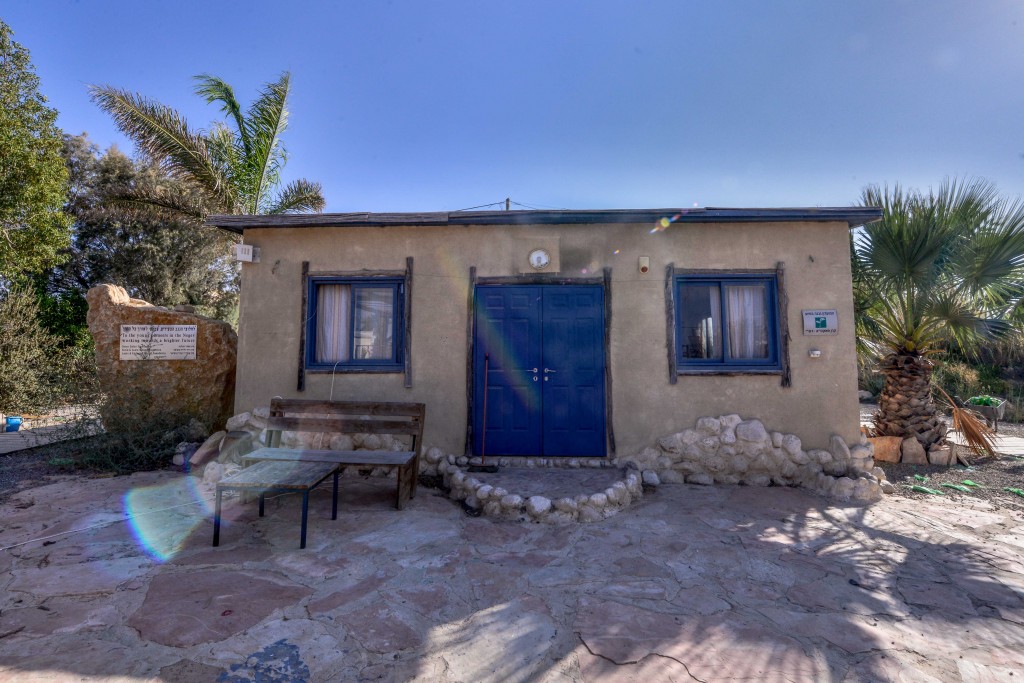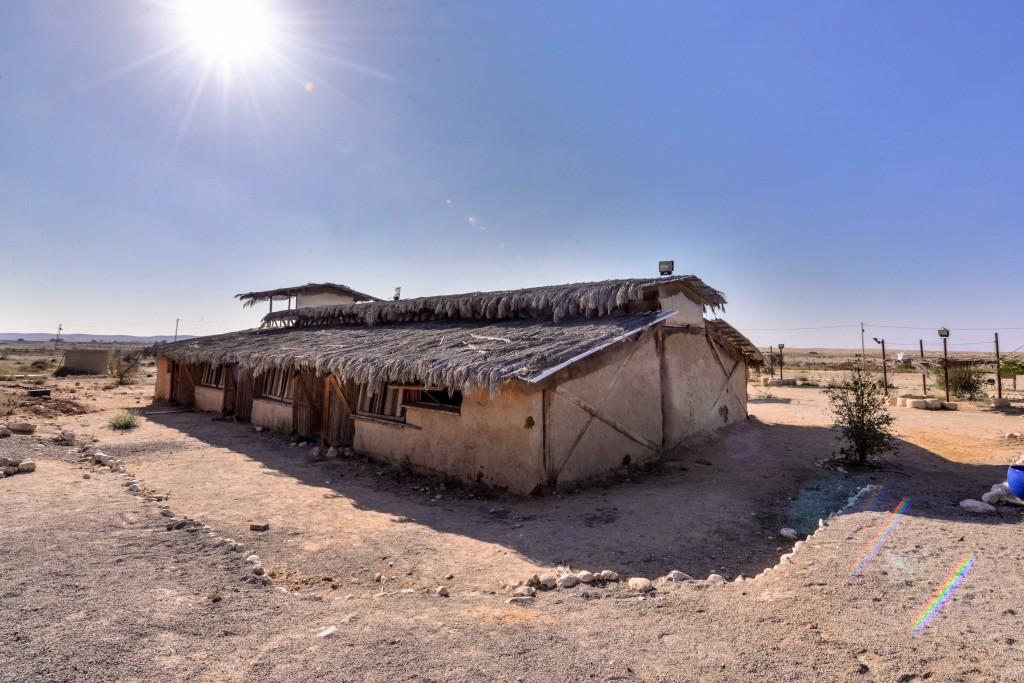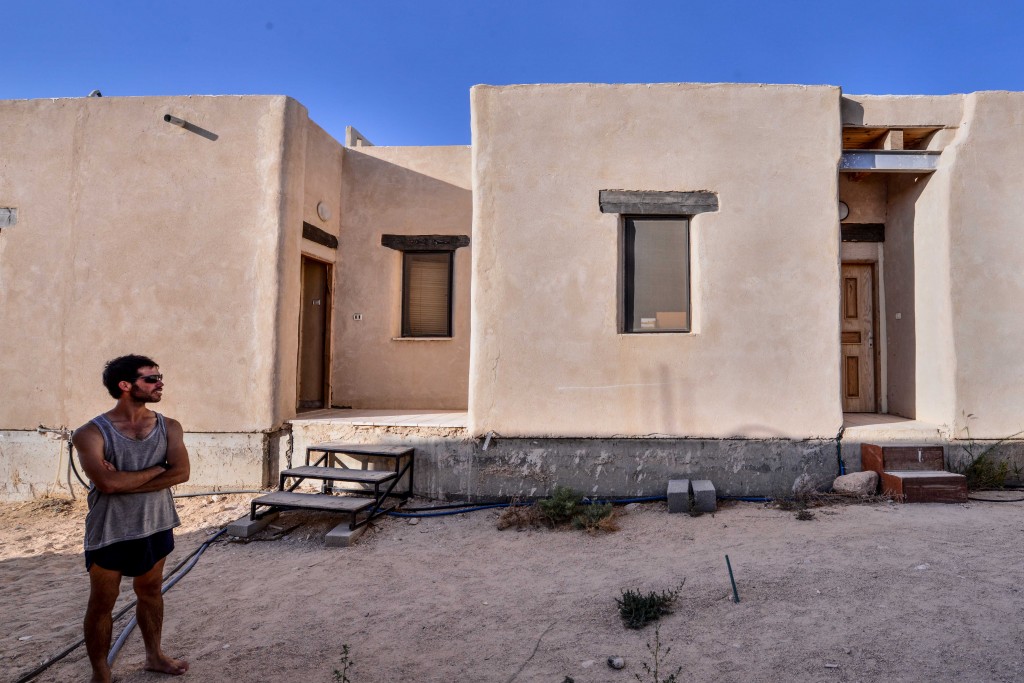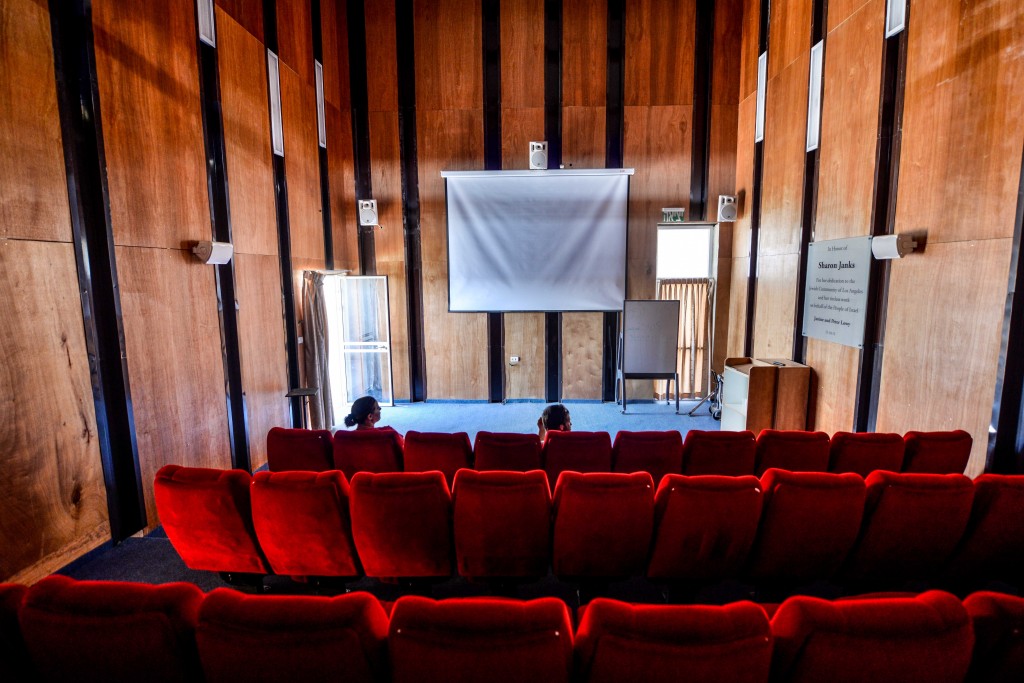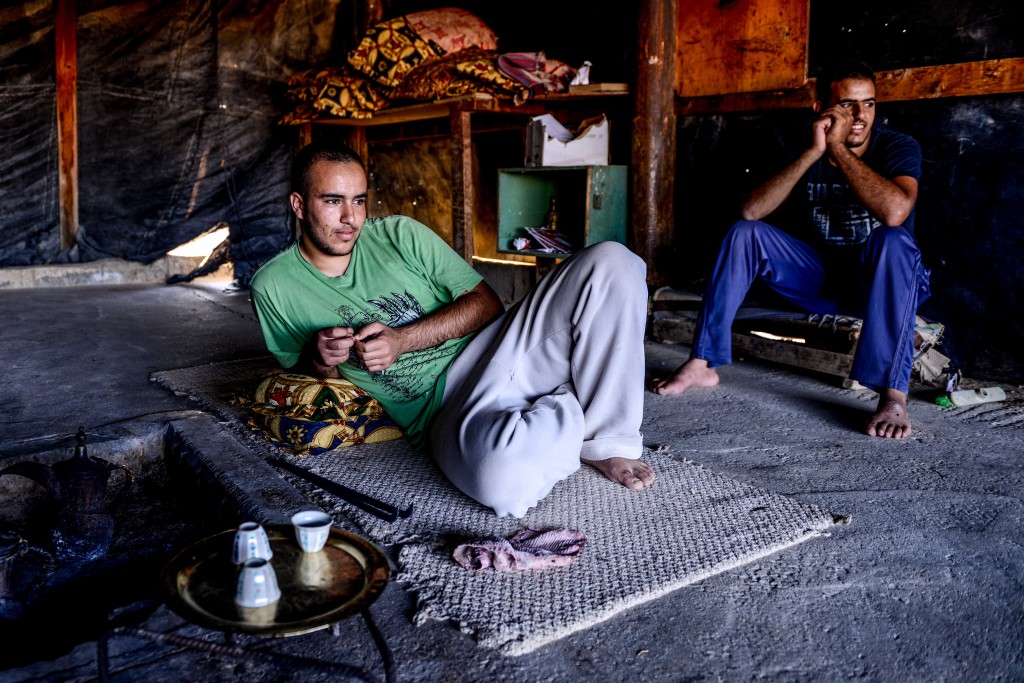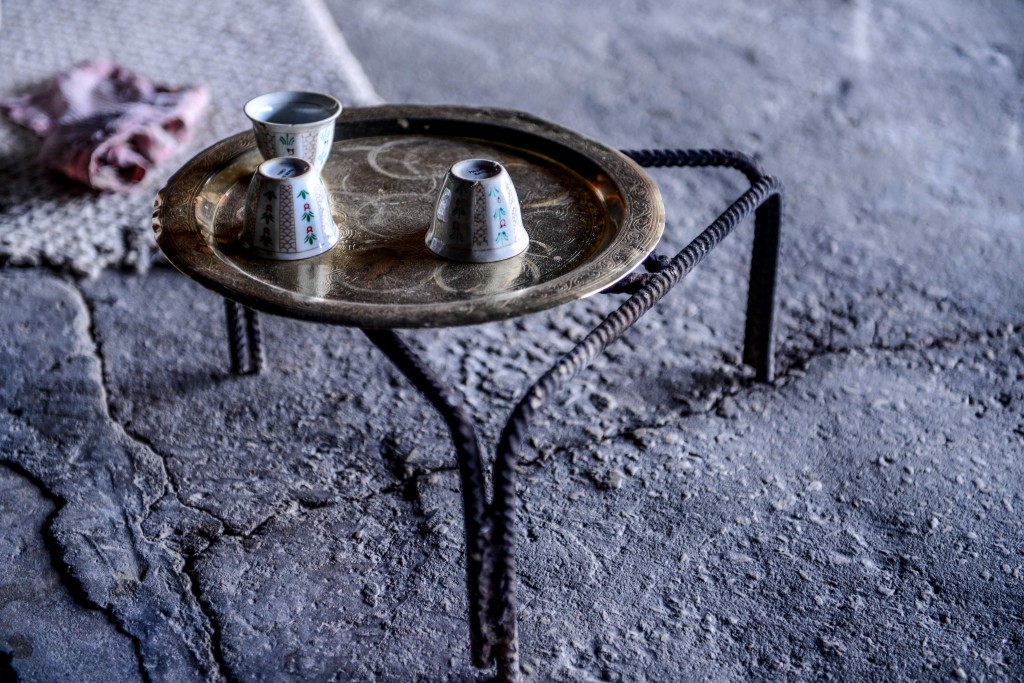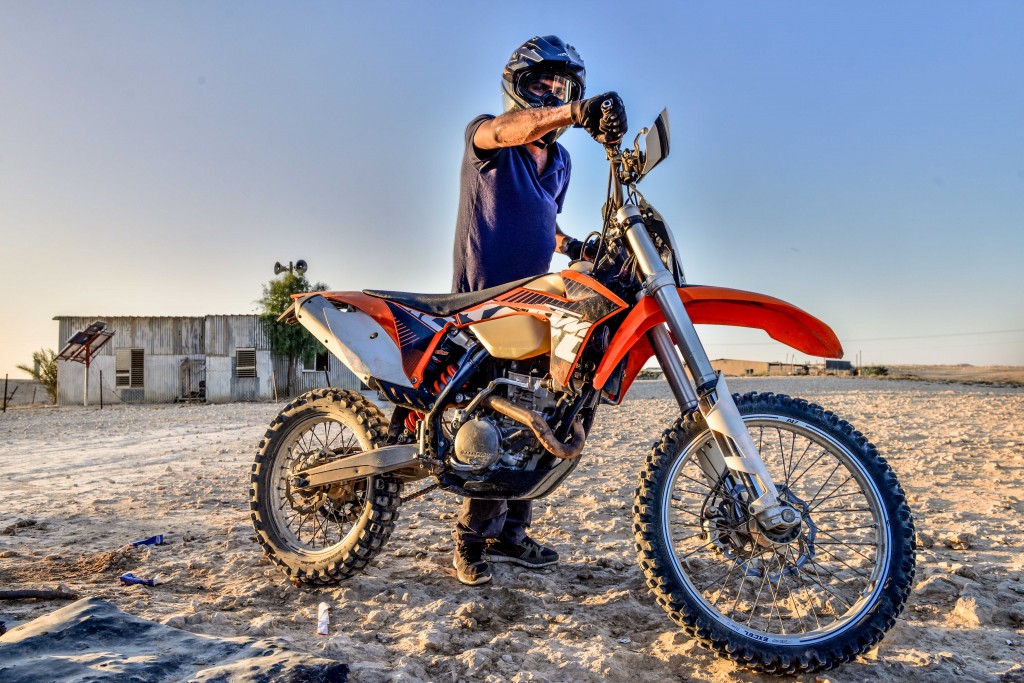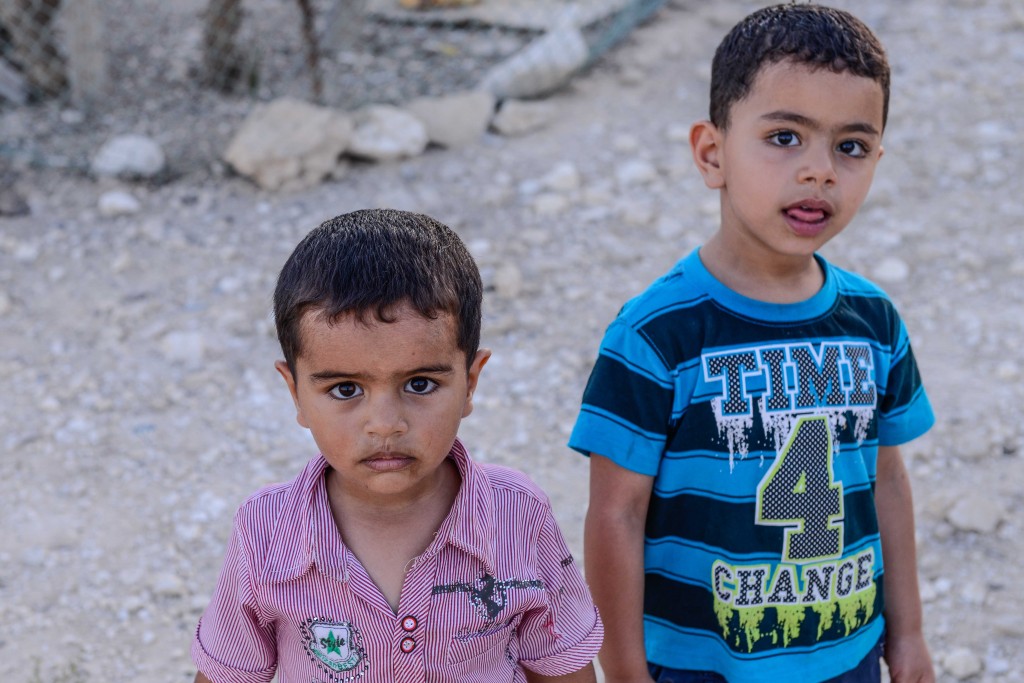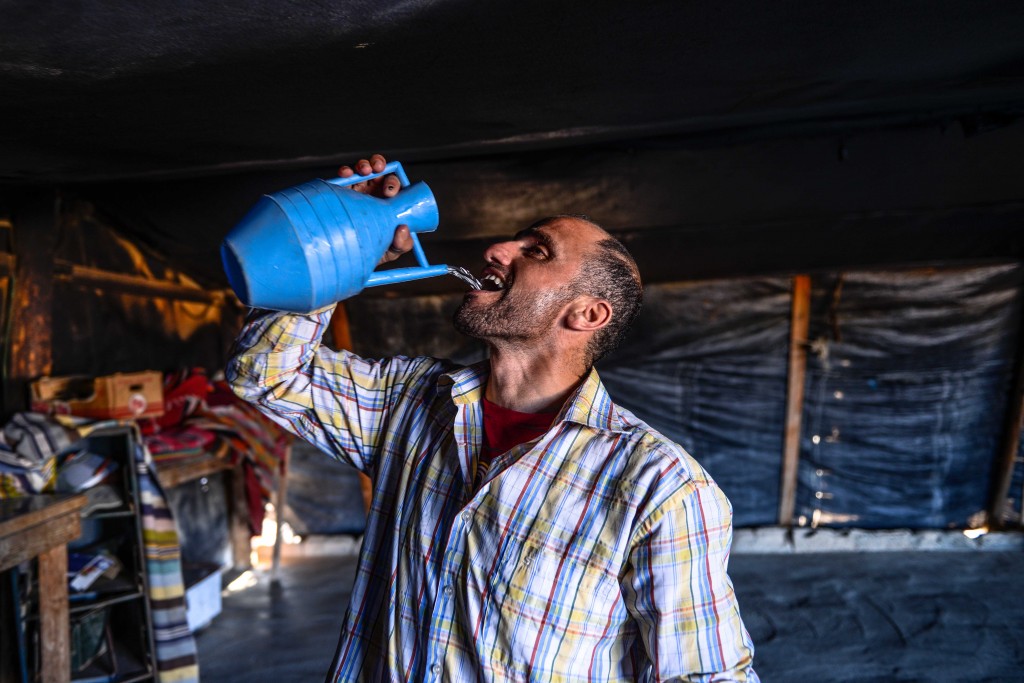The Bedouin see nomadic expansion as crucial to preserving their traditions. Jewish activists see settlement as the only hope of fulfilling Ben-Gurion’s dream. Israeli authorities see anarchy and potential disaster. What do you do when everyone’s right but no one should win? Photos by Aviram Valdman
“It took me twenty years to love this hole in the middle of nowhere,” wrote Shimon Adaf, one of Israel’s leading contemporary poets, in his poem “Sderot.” “Until I saw for the first time, with an accurate eye, the unsophisticated buildings beneath the roof of clouds, until I heard the wonderful rumbling of the street,” Adaf elegized, capturing the ambivalence of life in the desert for residents of the development towns. “Only places bereft of love are entitled to absolute love.”
Like its namesake southern Israeli town, “Sderot,” in spite of its bleak touches, shows something of the mythic and romantic perceptions of the Negev seen in Israeli literature and poetry, in Zionist thought and in the national consciousness. The contours of the desert, its wadis and wide-open expanses of sand and dust, are enduring and eternal, a source of inspiration and endless possibilities. “The smells borne by the wind, which provide a sense of perspective, a sense of proportion,” Amos Oz has said. “What’s important and lasting, and what is not important.”
It was the same for David Ben-Gurion. For him, the Negev, the southern stretch of varying desert that makes up more than half of Israel’s land mass, gifted to the Jewish people an opportunity to begin again. Through the settlement of the desert, through the mastery of nature and the redemption of the land, there would be a renaissance in Israel. The rebirth of a nation. “Why does a mother love her children so? Because they are her creation. Why does the Jew feel an affinity with Israel? Because everything here must still be accomplished. It depends only on him to participate in this privileged act of creation.”
Yihud hanegev, the Judaization of the Negev, is misunderstood if it is interpreted as colonialism or worse. Rather, it has been integral to Zionist theory since the three lookouts of Revivim, Gvulot, and Beit Eshel were founded in 1943 and Ben-Gurion first conceived his fantasy of making the desert bloom and filling it with four million Jews working in agriculture and industry. A consensus idea on the left and right, Jewish settlement of the Negev remains an essential project for the health, wholeness, and demographic balance of the state.
There have been victories in the Negev. Out in the Arava along the border with Jordan and the Eshkol Regional Council near the Gaza Strip, small agricultural communities, kibbutzim and moshavim, have flourished. Where there was once nothing, fields are sown with potatoes and sunflowers while date palms line the road to the Red Sea.
But due to a need to provide housing rapidly and cheaply, the state has mainly used the Negev as a space in which to dump waves of poor, working-class migrants from the Middle East and north Africa, Ethiopia, and the Soviet Union in development towns including Dimona, Ofakim, and Netivot. These towns continue to suffer weaker infrastructure, fewer employment opportunities, and higher rates of crime and urban depravation.
Today, there are more Israelis living in the small sub-district of Petah Tikva on the Sharon plain than the whole of the Negev, just 634,500 Israelis or 8.1 percent of the population. Within that number, 394,300 are Jewish, 6.7 percent of all Israeli Jews and around 62 percent of the population of the Negev. Jewish population growth in the Southern District is 1.1 percent. There has been, therefore, both a quantitative and qualitative failure to use the Negev to offer a better, cleaner way of life, abundant with culture and opportunity. Up until now, those who lived in the Negev did so because they were given no other choice.
In January 2006, the new Ministry for the Development of the Negev and Galilee was created, headed then by Shimon Peres. It has sought to push forward Blueprint Negev, a project of the KKL-JNF, which aims to attract 250,000 residents to Israel’s south, investing in new, modern communities and improving existing ones. Blueprint Negev is a recognition of the failure of the past, that the reality of Jewish settlement in the Negev has up until now been far from rosy.
The aim is to attract the middle-class to new towns with a quality of life unavailable in the crowded Sharon plain. In cooperation with the OR Movement—an organization dedicated to settling the Negev and Galilee—seven new communities have been established and ground has just been broken on an eighth, Carmit. Casif, a new town for Haredim, will follow. In Beersheba, as part of municipal plans to double the population of the city and construct thousands of new housing units, KKL-JNF are regenerating the riverside areas in order to create a park for all the city’s residents.
This construction occurs against the background of the Israel Defense Forces’ plan to move a great many of its operations from the centre to the south. By 2015, a new training complex will house around 10,000 soldiers and employ another 500 civilian workers. In addition, two large bases will be built near Beersheba: a Military Intelligence base due to open in 2019 and a teleprocessing and information technology base due to open in 2018. By the end of the decade, Ha’aretz’s Gili Cohen reports that “much of the IDF will operate in the south, including 30,000 soldiers and around 6,000 career officers.”
The government also plans to extend transport arteries in order to make living in the south yet working in the center a more viable option. Highway 6—the Trans-Israel Highway which at present runs from Elyakim in the north to Kiryat Gat in the south, will be extended into the Negev to reach Lehavim, Beersheba, the Nevatim airbase, and eventually Yeruham. Eilat will get a new airport in the Timna Valley, while a new railway line will connect Beersheba to Ashkelon, via Ofakim, Netivot, and Sderot.
By its nature, Blueprint Negev cannot be pioneering. It is a state-led programme in which development towns have been replaced with bedroom communities. But there are NGOs working outside of it to embed roots in the peripheries, evoking the spirit of Ben-Gurion who left the most important office in Israel to work as a farmhand and establish a new life on Kibbutz Sde Boker.
Twice a year, Ayalim sends hundreds of students and pre-army volunteers out into the Negev and Galilee to establish new student villages. In the Negev, Ayalim presently has communities for students in Beersheba, Arad, Dimona, Yeruham, Ofakim, Ashalim, and Yachini. In October, they will break ground on a new village in Mitzpe Ramon.
“In the mold of the pioneers, we wish to bloom the Negev according to Ben-Gurion’s dream, but adapted to the needs of the twenty-first century,” Ziv Shalev, VP for Partnership Development, explained as he showed me around Kfar Adiel near Ashalim. “Our principle is that strong, young people secured in communities in the Negev and Galilee will become role models for others.”
Home now to 80 students, most of whom study in Beersheba, Kfar Adiel started life as a single caravan and now has rows of single-story homes built with eco-mud bricks to counter the dry, intense heat of the desert. Ayalim has also built multi-purpose community facilities, as well as a swimming pool and a cinema. “The student village becomes a catalyst, secured in the communities as role models,” Shalev says. “The more Kfar Adiel flourishes, the more Ashalim will also flourish.”
Through engagement in local communities, raising the standards of their surrounds and elevating the status of the entire Negev, “this way of building and living connects young adults to the land and to these places,” Shalev says. By bringing people here to the Negev while they are students, connecting them to the land and the people around them, the hope is that “once they graduate, they will choose to return and live here and in turn influence others to live here. Through this, we can change the balance in the Negev.”
By itself, Ayalim cannot encourage mass settlement. “Each village we create brings 100, maybe 120 young people here.” But it can play its role in the larger Zionist project. “Ayalim’s concern is bringing many strong, young adults to the Negev and the Galilee. We are not a political movement in that sense, but we are a movement that believes Israel is a Jewish state,” Shalev adds. “So, on the one hand, students working with Ayalim volunteer with the Bedouin, working with the children and in education. We do not care who our neighbours are. But, we believe that if there are more Bedouin in this region than Jews, we have lost the Negev.”
While the Negev is underdeveloped and under-populated, it is not empty. To drive around the northern Negev today is to witness Israel’s other challenge in the desert. Along the highways, around the cities and kibbutzim, and off the main roads along bumpy dirt tracks, the land has grown thick with shacks and shanties that are home to a great number of Israel’s Bedouin. Most of this construction is clustered into thirty-five unrecognized or illegal villages which do not appear on official maps and lack infrastructure such as water, electricity, sewage, health, and education services.
Prior to the establishment of the State of Israel, Bedouin Arabs lived in and worked the Negev for hundreds of years as farmers, herders, and trackers. After the War of Independence, during which a great many fled to Jordan and Egypt, the remaining 11,000 Bedouin were concentrated into an area known as the Siyag, a roughly triangular space east of Beersheba, west of Arad, and north of Dimona. Within the Siyag, an estimated 206,000 Bedouin today reside, of which 30,000-70,000 live in the dispersal.
Since 1966, government policy towards the Bedouin has focused on urbanization. “We should transform the Bedouins into an urban proletariat—in industry, services, construction and agriculture,” Moshe Dayan said in 1963. “Eighty-eight per cent of the Israeli population are not farmers. Let the Bedouin be like them. Indeed, this will be a radical move which means that the Bedouin would not live on his land with his herds, but would become an urban person who comes home in the afternoon and puts his slippers on. His children will go to school, their hair combed and parted. This will be a revolution, but it can be achieved in two generations.”
From 1966 up until the 1990s, the first attempt to urbanize the Bedouin resulted in the establishment of seven towns, home today to 136,500 Bedouin: Rahat, the largest with a population of 54,900; Kuseife; Hura; Tel Sheva; Arara BaNegev; Laqye; and Segev Shalom. In addition, at least 13,200 Bedouin live in eleven newer villages recognized when the government of Ariel Sharon created the Abu Basma Regional Council to oversee the development and recognition of these municipalities.
No additional villages have been recognized since 2004, however, and as a consequence an unhealthy status quo of unrecognized construction, neglect, demolition, and land disputes has festered. In order to resolve this, the state has conceived a new master plan. The Prawer Plan allows for the possible evacuation of all of the thirty-five unrecognized villages, with the Bedouin resettled in permanent dwellings either in the seven established towns, the eleven villages of the Abu Basma Regional Council, in an unrecognized village if it can be regulated or retroactively legalized, or in new settlements to be constructed.
The Prawer Plan asserts that the “vast majority” of those currently living in unrecognized villages can continue to live on the same patches of land in “formalized settlements,” while those forced to relocate will benefit from greater access to government services including education and healthcare. The Bedouin are entitled to submit ownership claims to the land they are on in court, with the government offering up a counter-claim and the burden of proof falling on the Bedouin to show their right to the land. Due to the nature of the system, however, 100 percent of judicial claims have fallen on the side of the government to date.
The Israel Land Authority, the government bureau responsible for the management of state-owned land, asserts that leaving the dispersal for recognized towns and villages is the only future available to the Bedouin. In the Knesset, the Prawer Plan is backed by the government yet opposed by the Left opposition. Meretz chair Zehava Gal-On called it “a one-sided plan that ignores the demands and needs of the Bedouins, and means displacing and dispossessing tens of thousands of their villages. The starting point is that the Bedouins are invaders, not citizens with equal rights.” Labor’s Merav Michaeli added, “The government has a hard time understanding this is about Israeli citizens. From the beginning, they have denied and ignored the Bedouin population. They probably hoped they would disappear.”
Labad Abu Afash, chair of the village committee of Wadi al-Na’am, invited us into the tent—a semi-permanent structure with concrete walls and a corrugated roof—where the men typically gather to talk politics. He served us dark Arabic coffee and a sweet tea perfumed with mint leaves.
Wadi al-Na’am is one of the thirty-five unrecognized villages, ten kilometers south of Beersheba. It is accessible only by a dusty, uneven trial off Route 40, lined with banks of rubble and debris. At the end of the way is a school, constructed by the state using temporary huts and powered by generators and solar panels since the government will not allow it to be connected to the grid. The school serves the children of Wadi al-Na’am as well as those from nearby unrecognized villages, who are bussed in, also at the expense of the state.
This school and the village are bunched up against a power station and Ramat Hovav industrial zone, home to chemical plants and a hazardous waste disposal facility. The Negev Coexistence Forum (Dukium) asserts these sites cause “grave environmental pollution and present major health hazards such as high rates of cancer, a high infant mortality rate, respiratory problems for children, and skin diseases.” Under the Prawer Plan, Wadi al-Na’am would be evacuated, the residents moved to a new suburb of Segev Shalom.
The Bedouin of Wadi al-Na’am reject the proposed move to Segev Shalom, and have been in negotiations with the government for three years regarding the future of their village. Dukium assert that their alternative suggestions of relocation to a rural, agricultural setting within Bar Hadaj or near Beit Kama were not listened to. “We do not want conflict or violent struggle with the state and we do not wish to continue living without infrastructure and development,” Abu Afash explained. “But we do seek to preserve our way of life as a rural agricultural community. The problem is the state tries to dictate a narrow, proscribed way of life.”
The Bedouin regard the seven established towns and the project of urbanization as a failed experiment. Camel Elamrani, principal of the community centre youth department in Segev Shalom, explained that there were promises regarding infrastructure and modernisation that were not fulfilled. “There is a big problem of density as there is no development of new spaces of construction, leading to a situation where a few families live in the same houses, up to 40 or 50 people. Young couples don’t have the space to build new homes for themselves.”
Those who live in the dispersal do not wish to leave it, and those who have already done so would not wish their urbanized life upon those still living in rural communities. “We resist the relocation of Wadi al-Naam because we know the hardship of adjustment to the settled way of life and we would like to be able to use that land to build new homes for young couples,” Elamrani concluded.
Urbanization has changed the ways in which the Bedouin live and interact with one another. Bedouin in the towns are more likely to be employed as opposed to self-employed. The whole social structure has evolved—residents see themselves as part of a wider community or society, not only as part of their own family. Urbanized Bedouin have a different cultural codes to those in the village, over the wearing of short trousers or going without the hijab.
There are positive, modernizing aspects to this change, but the disillusionment at the perceived failures of urbanization have created an “alienation between the Bedouin and the institutions of the state,” Elamrani said. “We wanted to be equal citizens of the state with equal rights and equal treatment. The poor conditions of the Bedouin are not good for anyone—not for the Bedouin, not for the Jews. The state treats the Bedouin as a problem that needs to be solved—they do not treat the problems of the Bedouin themselves.”
How to resolve the status of the Bedouin on the land while lifting them out of poverty, at the same time as encouraging Jewish settlement in the Negev, has become an existential test for the State of Israel. It is a test of the state’s ability to settle the legal and documented claims and assert the rule of law, while protecting the Bedouin’s marginalized culture in a manner in-keeping with the humane values of a Jewish and democratic state.
Gritty and ugly, sometimes brutal, the disagreement between the Bedouin and the state has attracted political organisations, pressure groups, and human rights watchdogs to the scene. Dukium is one example: a joint Jewish-Arab organisation which seeks to advance the Bedouin’s cause by helping to deliver basic services, petitioning the government, staging protests in Beersheba and in the unrecognized villages, as well as hosting journalists and activists and giving them tours of the Negev.
Among the more interesting of the NGOs working with the Bedouin is Bimkom. Founded in 1999 by planners and architects, it is working on an Alternative Master Plan for Bedouin Villages in the Negev as a counter to the government’s policy of sedantarisation in the seven established towns. “The Bedouin village is a distinct type of settlement whose plans should take into consideration its inner rationale,” they argue, which includes thinking about their cultural and social organisation and the traditional system of land allocation and use.
But it is not only the Left that is working in the south. Regavim are relatively new to the scene and are working to advance a more nationalistic position on the “responsible, legal and accountable use of Israel’s national lands and the return of the rule of law to all areas and aspects of the land and its preservation.” “The government has been irresponsible in how it has managed an important resource,” Ari Briggs, Direction of International Affairs at Regavim, informed me as we toured the northern Negev. “There now has to be a comprehensive solution for the Bedouin in the Negev.”
Regavim operates through the legal system, and has worked to halt “new illegal construction by Bedouin in the Negev and to prevent them from taking over more land.” Among their achievements they count “a precedent-setting ruling ordering the Abu Basma Regional Council to demolish 65 houses illegally built in the Negev within a year” and as well as the drafting of their own plan called Yesh Pitaron—There Is a Solution—for the settlement of the Bedouin in the Negev.
In the eyes of Regavim, however, the Bedouin are not partners but a fifth column, working from the Galilee through the West Bank and the Negev to “disinherit the Jews of their land,” part of a “silent conquest” and “settling of the Land of Israel by foreigners.” Their presence is an indication of the temperature of feeling in the south at this time, a region on the edge of conflagration.
Today the Negev is a crucible, host to a fiery collection of dreams and arguments, claims and counter-claims. The dream of Jewish settlement and of yihud hanegev. The wish of the Bedouin to reside on what they view as their ancestral lands, maintaining a traditional rural and agricultural way of life. The unstoppable forces of modernisation, sedentarization, and urbanization. The need for the state to impose rule of law and settle the legal and documented claims to the land.
In 1955, two years after leaving government to settle in the arid environs of Sde Boker, David Ben-Gurion gave a speech entitled “The Significance of the Negev.” In it, he said:
It is in the Negev that the people of Israel will be tested—for only with a united effort of a volunteering people and a planning and implementing State will we accomplish the great mission of populating the wilderness and bringing it to flourish. This effort will determine the fate of the State of Israel and the standing of our people in the history of mankind.
Ben-Gurion’s words remains as true now as then. The land from Gedera to Hadera is densely populated and more crowded than Israel’s peripheries. The expanse of desert and rock from Beersheba to Eilat continues to offer the people of Israel a space to test their “pioneer strength, vigour of spirit, and creative and conquering initiative,” as Ben-Gurion believed it might, if they willed it so. While his vision of a Negev populated by four million Jews has been and continues to be a vision far off into the distance, Blueprint Negev’s aim of 250,000 new inhabitants is an achievable first step.
But Ben-Gurion words demand another interpretation, as well. As one of Israel’s other founding pioneers, the brilliant chemist-statesman Chaim Weizmann, Israel’s first president, noted, “The world will judge us by how we treat the Arabs.” This belief was codified in Israel’s own Declaration of Independence, where the builders of the country stated that Israel would be “open for Jewish immigration and for the Ingathering of the Exiles,” but would also “foster the development of the country for the benefit of all its inhabitants” in a state “based on freedom, justice and peace as envisaged by the prophets of Israel” that ensured the “complete equality of social and political rights to all its inhabitants irrespective of religion, race or sex.”
It does not have to be the case that the dreams of Jews and Bedouin in the Negev must compete for supremacy as they do now. The current contest has been brought on by failed policies and years of disregard, and has been magnified by the involvement of interest groups from both inside and outside Israel. The Declaration of Independence demands that a compromise be found, one that allows Jews to build homes and raise families, plant trees and fall in love in any part of their homeland while protecting the dignity of the Bedouin and their right to maintain a rural and agricultural way of life with access to government services and benefits.
To reconcile the desires of Jews and Bedouin in the Negev is to come to terms with the complexities inherit to Israel’s founding principles. It’s to understand—to be forced to understand—what it means to be a Jewish and democratic state. “It is in the Negev that the people of Israel will be tested,” Ben-Gurion forewarned. Almost sixty years later, Ben-Gurion’s prediction is only beginning to come true.
![]()
Banner Photo: Aviram Valdman






